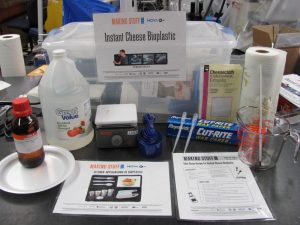Our kits are currently being reviewed and updated by a team of collaborative, innovative and interdisciplinary educators who wish to enhance the educational opportunities for students. These dedicated teachers are members of CRISP Collaborative Science for All (CCSA) as well as local educators.
Click to see the SCSU CRISP Module Template used by CCSA for improving and updating the CRISP demos and kits. Each kit page offers a CRISP developed teacher module and CRISP aligned standards (both NGSS and CCSS)
Kit Request form

Learn about bioplastic, a material made of plant or animal matter that is cleaner because it breaks down more easily in the environment than petroleum-based synthetic plastics, by making and exploring a simple bioplastic by curdling milk with vinegar in a process similar to cheese making.
Adapted from Making Stuff Cleaner by NOVA via the Making Stuff project
Subject(s):
Polymers, Bioplastics
Objectives:
Students should be able to:
- Explain how the chemical structure of polymers affects their physical properties.
- Explain the general formation and structure of carbon-based polymers, including synthetic polymers.
- Explain how simple chemical monomers can be combined to create linear, branched and/or cross-linked polymers.
- Observe the structure and function of everyday polymers.
Materials in this kit:
- cheesecloth or fine strainer
- clear glass cooking pot* or large, glass Pyrex® measuring cup
- container to catch the whey liquid
- hot plate, microwave, or other heat source (or preheat the milk to more than 37°C/98°F—do not boil or scald—and keep it in a Thermos)
- large spoon for stirring
- paper towels
- safety goggles
- scissors (to cut cheesecloth, if using)
- thermometer
- vinegar, 2 tablespoons per cup of milk
- wax paper
- examples of biodegradable plastics, if available
- examples of casein plastics, if available
- milk, 1 cup ** not provided
- cheese cubes in a plastic baggie ** not provided
Suggestions for the Teacher:
This kit requires some advanced preparation
Safety:
- Have your students put on safety goggles.
- Be sure the students use caution when using the scissors
Additional Resources:
Making Stuff Cleaner: Instant Cheese Bioplastic Teacher module
Making Stuff Cleaner: Instant Cheese Bioplastic CRISP aligned standards
Bioplastics Guide from NOVA
Bioplastics recipe from NOVA
Making Stuff Website
Making Stuff Cleaner
NOVA
STEM Careers:
Standards:
5-PS1-1
- Develop a model to describe that matter is made of particles too small to be seen.
MS-PS1-2 Matter and its Interactions
- Analyze and interpret data on the properties of substances before and after the substances interact to determine if a chemical reaction has occurred.
HS-PS2-6
- Communicate scientific and technical information about why the molecular-level structure is important in the functioning of designed materials.
MS- PS1.A: Structure and Properties of Matter
- Each pure substance has characteristic physical and chemical properties (for any bulk quantity under given conditions) that can be used to identify it.
CC-3 Scale, Proportion, and Quantity
- Natural objects exist from the very small to the immensely large.
MS - Patterns
- Macroscopic patterns are related to the nature of microscopic and atomic-level structure
SEP 2- Developing and Using Models
- Use models to describe phenomena.
SEP 4 – Analyzing and Interpreting Data
- Analyze and interpret data to determine similarities and differences in findings.
SEP 6 – Constructing conclusions and designing solutions
- Construct and revise an explanation based on valid and reliable evidence obtained from a variety of sources (including students’ own investigations, models, theories, simulations, peer review) and the assumption that theories and laws that describe the natural world operate today as they did in the past and will continue to do so in the future.
Suggested Video(s):
http://www.pbs.org/wgbh/nova/tech/making-stuff.html#making-stuff-cleaner
